New Jersey Future Blog
Housing Costs, Property Taxes Shift Along with Population
May 7th, 2008 by Tim Evans
- Gloucester County still leads New Jersey’s 21 counties in population growth, growing by 1.58 percent between 2006 and 2007, nearly seven times the statewide growth rate of 0.23 percent. Somerset (1.09 percent) and Cumberland (0.89 percent) were the second and third fastest-growing counties in the past year, respectively.
- Several counties in eastern Pennsylvania continue to rival or even outpace the fastest-growing New Jersey counties. Pike County, across the Delaware River from the northern tip of New Jersey, grew by 2.41 percent from 2006 to 2007. Northampton County, across the river on I-78, grew by 1.25 percent. Monroe County, across the river on I-80, grew by 1.11 percent.
- Pike and Monroe counties have been the two fastest-growing counties in the Northeast since 2000, fueled largely by relocating New Yorkers and New Jerseyans.
- But Northampton (which includes the cities of Bethlehem and Easton) is relatively new to the game of absorbing New Jersey out-migrants; this is the first year Northampton has grown faster than Monroe.
Economic Peaks and Valleys in the Poconos
County population estimates released by the Census Bureau in March reflect the continuation of previous trends, but with a few new wrinkles. For more than a decade, Pike and Monroe counties in northeastern Pennsylvania have been growing faster than any of the counties of northern and central New Jersey, as more and more residents of New Jersey and New York City have decamped for the Poconos in search of cheaper housing and lower property taxes. But Monroe County, at least, looks like it may be hitting a plateau.
For the first time, Monroe’s annual growth rate was exceeded by Northampton County’s. This is also the first time in many years that any county in northern or central New Jersey has come close to equaling Monroe’s growth rate; between 2006 and 2007, Somerset County’s growth rate of 1.09 percent nearly matched Monroe’s 1.11 percent.
Other statistics portend New Jersey-like problems ahead for Monroe. The county experienced a sharp spike between 2000 and 2006 in terms of the median percent of total income spent on housing costs—from 21.9 percent in 2000 to an estimated 26.7 percent in 2006. Monroe’s median housing burden, which had been running near the middle of the pack compared to New Jersey just a few years ago, now outpaces 16 of New Jersey’s 21 counties. The median Monroe County household is now spending more of its income on housing than is true anywhere in the northern New Jersey suburbs.
Likewise, property tax bills have been rising fast in Monroe—a 48.2 percent jump in the median tax bill between 2000 and 2006, according to Census Bureau estimates. While still below the median property tax bills in the counties of northern and central New Jersey in absolute terms, Monroe’s percent increase was larger than in all but four New Jersey counties—Hunterdon, Somerset, Salem and Gloucester.
Transportation Costs Loom Large
The Census Bureau produces county population estimates annually, with July 1 as the reference date. Thus, these county estimates predate the recent rapid increase in gasoline prices. With many Monroe County residents continuing to commute to New Jersey or New York for their jobs (the percentage of Monroe residents who worked in another state stood at 23.2 percent as of 2006, higher than any New Jersey county except Hudson), skyrocketing fuel prices are likely to cause transportation costs to loom even larger as another factor eating into the household budgets of Monroe County residents.
For well over a decade now, New Jersey’s de facto “solution” to its housing and property tax problems has been to assume that eastern Pennsylvania would simply clean up after it, providing a haven for New Jersey workers who couldn’t afford the residential price of admission. But with rising gas prices and rising real estate tax bills in Monroe County (2006 statistics are not available for Pike County) changing the parameters of the trade-off between housing costs and transportation costs, perhaps the time has come for New Jersey to put some serious effort into attempting to house its own workers. Otherwise, jobs may finally begin following residents across the river.
If you have any questions about this issue of Future Facts, please contact Tim Evans, Research Director.
















